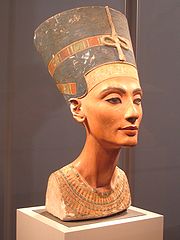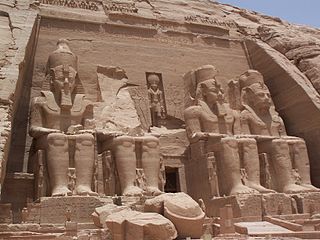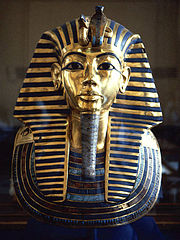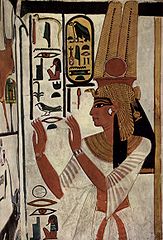What Was the Purpose of Art in Ancient Egypt?
Art History and Artists
Aboriginal Egyptian Art
History >> Art HistoryA lot of what we know about the Aboriginal Egyptians comes from their art. From the many pieces of art they created nosotros tin can learn things similar what they looked like, what kind of clothes they wore, what jobs they worked, and what they considered important.

Nefertiti by Unknown
Similar Fine art for Over 3000 Years
The civilisation of Ancient Arab republic of egypt ruled the state of the Nile for over 3000 years. Surprisingly enough, their art changed little during that time. The original style of art was showtime used in 3000 B.C. and the most respected artists continued to copy these styles for the next 3000 years.
Religion and Art
Much of the artwork created by the Ancient Egyptians had to do with their religion. They would fill the tombs of the Pharaohs with paintings and sculptures. Much of this artwork was there to help the Pharaohs in the afterlife. Temples were some other popular place for art. The temples oftentimes held large statues of their gods as well equally many paintings on the walls.
Egyptian Sculpture
The Egyptians are famous for their giant works of sculptures. Some examples of this include the Great Sphinx of Giza and the statues of Ramses II at the Abu Simbel temples.

Abu Simbel Temple by Than217
Click picture for larger view
In the in a higher place picture the statues of Ramses II are shown. They are each over 60 feet tall. The Sphinx at Giza is over 240 feet long!
Although they are famous for their giant statues, the Egyptians as well carved smaller, more ornate sculptures. They used various materials including alabaster, ivory, limestone, basalt, wood aureate with gold, and sometimes even solid gold.

Golden funeral mask of Tutankhamun past Jon Bodsworth
Click picture for larger view
To a higher place is an example of the intricate piece of work of Aboriginal Egyptian sculpture. It is the funerary mask of a pharaoh named Tutankhamen. The expression on his face is the same used to convey the look of all the pharaohs throughout the history of Egypt. The coloring of the collar is made with semiprecious stones and the stripes on the headdress are made with blue glass. The rest of the mask is made from 20-four pounds of solid golden!
Egyptian Painting and Tomb Walls
In Aboriginal Arab republic of egypt the tomb walls of the rich and powerful were oftentimes filled with paintings. These paintings were there to help the person in the afterlife. They often depicted the person buried passing into the afterlife. They would show scenes of this person happy in the afterlife. In one painting the man buried is shown hunting and his wife and son are in the picture.

Nefertari from the Yorck Projection
Click pic for larger view
The above painting is a moving-picture show on a tomb wall of Queen Nefertari, wife of Ramses the Great.
Relief
A relief is a sculpture that is part of a wall or structure. The Egyptians often carved them into the walls of their temples and tombs. Reliefs were generally painted as well.
Interesting Facts virtually Aboriginal Egyptian Art
- They mostly used the colors blue, blackness, crimson, green, and gold in their paintings.
- A lot of Egyptian art depicted the pharaohs. This was ofttimes in a religious sense as the pharaohs were considered gods.
- Many of the paintings of Ancient Egypt survived for so many thousands of years because of the extremely dry out climate of the area.
- Pocket-sized carved models were sometimes included within tombs. These included slaves, animals, boats, and buildings that the person may need in the afterlife.
- A bulk of the art hidden in tombs was stolen by thieves over thousands of years.
- Take a 10 question quiz virtually this folio.
- Mind to a recorded reading of this page:
More information on the civilization of Aboriginal Arab republic of egypt:
Works Cited
History >> Art History >> Ancient Egypt for Kids
0 Response to "What Was the Purpose of Art in Ancient Egypt?"
Enregistrer un commentaire